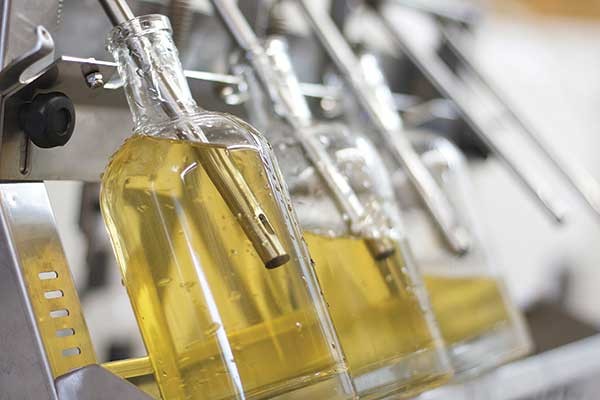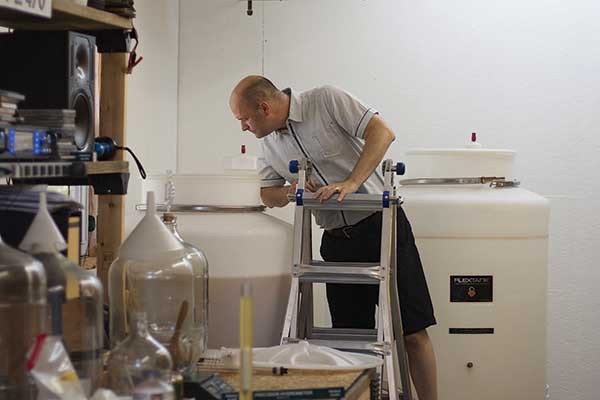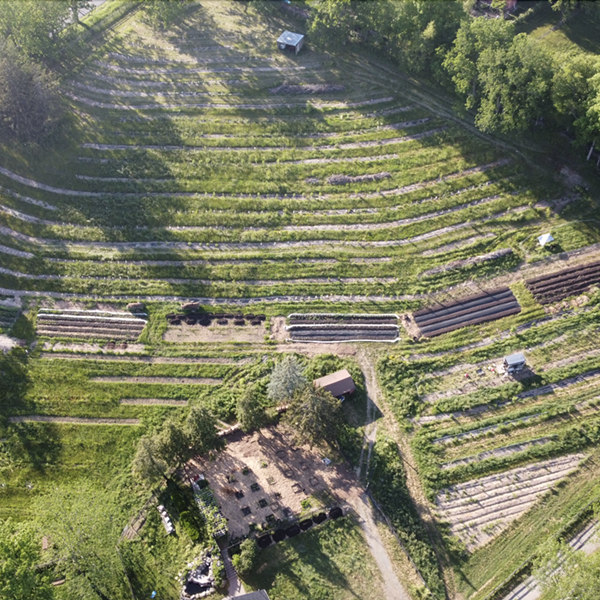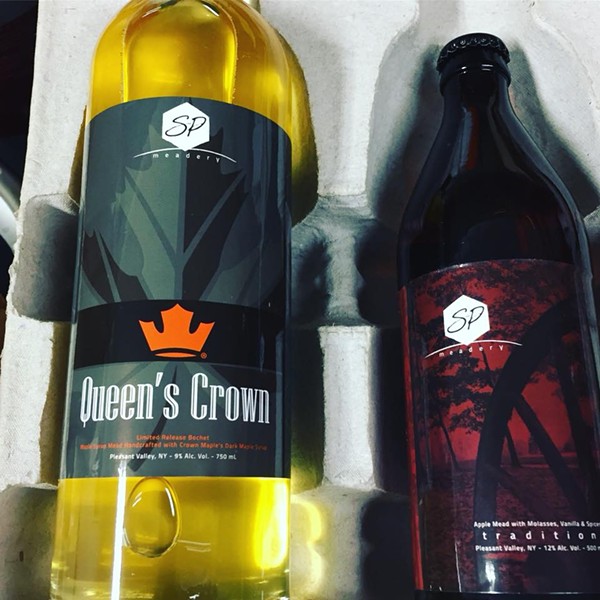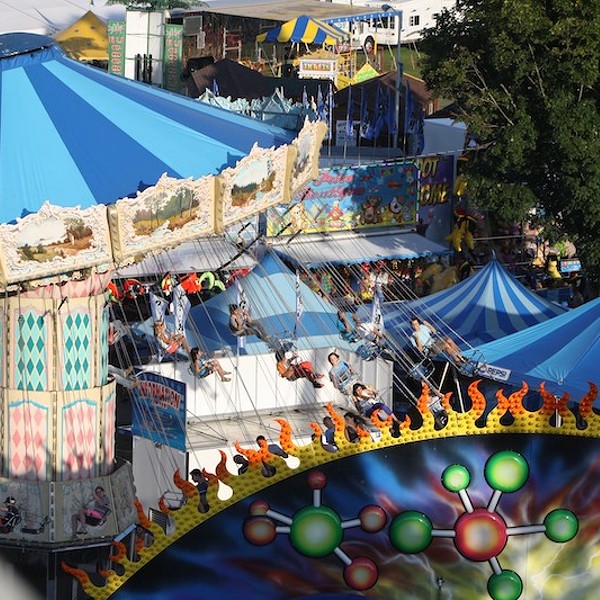It seems worthwhile, on the heels of the beekeeping piece last month, to hip you all to the leading edge of a new mead industry that could well take its place alongside hard cider and microdistilling as another excellent artisanal expression of our region's natural bounty. Honey is a powerfully antimicrobial substance; its high sugar concentration and the hydrogen peroxide it contains in small amounts makes it an impossible medium for bacteria or yeast to earn a living on. Dilute it with water, however, by about four to one, and fermentation will occur. The result is mead, the oldest alcoholic drink in human history. Mead dates back to the dawn of civilization, before agriculture: Traces of honey and rice have been found in 10,000-year-old Chinese fermentation vessels. (Some historians have posited that our urge to ferment grains gave rise to agriculture in the first place; we all descend from brewers and drunkards).
Peter Voelker started making mead as a hobby about 15 years ago, after his homemade beer failed to excite him: "I couldn't make anything as good as the craft beers I was buying." He turned to mead, and spent the ensuing period experimenting and modifying his recipe until he arrived at the current version. Now the situation is reversed: "I have never tasted better than the mead I am making." Last year, he turned pro, founded Helderberg Meadworks, and began selling his Heritage mead from his home in Duanesburg, a few miles outside of Schenectady. Voelker self-funded the modest equipment cost, and with virtually no overhead he broke even the first year.
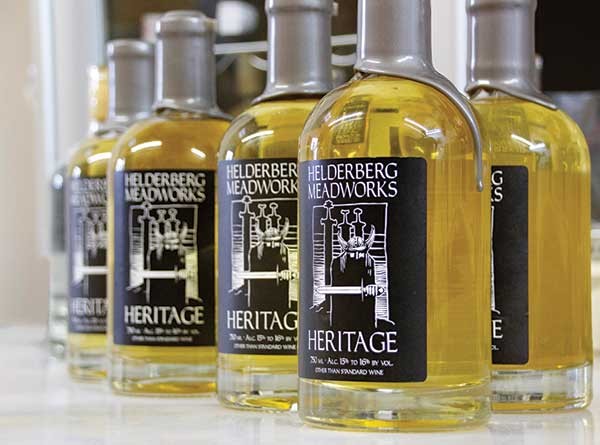
In France, unorthodox small-scale winemakers are known as "garagistes." Voelker embodies this descriptor quite literally; his bonded, licensed facility consists of a long, narrow room he walled off from his garage when he took the plunge and got all the federal, state, and local permits required to make mead commercially. Coils of plastic tubing hang along one wall, and several hulking white plastic fermentation tanks huddle at the end of the room. On a table sit bottles from both vintages (he is prohibited from putting a vintage on the label, but he changes the wax color each year to tell them apart).
Trained as a nuclear and civil engineer, and still holding down a day job in the latter capacity, Voelker hopes someday that his side project will become his sole occupation. It's not unlikely; his first two vintages are sold out and he's waiting impatiently for the current batch, quietly frothing in two 200-gallon tanks, to finish fermenting so he can bottle it. Selling everything is a good problem to have, he admits, but "telling stores that I have nothing left to sell them sucks." In response to the enthusiastic demand, his anticipated production curve for next year next year has steepened, from 400 cases to 800. Two new 300-gallon fermenters sit empty alongside their busy brethren in anticipation. His wife Kirsten helps out on the business side, but it's essentially a one-man operation.
Voelker, though imposingly tall, still looks every bit a mild-mannered, middle-aged engineer. His calm demeanor belies a deep connection to one of mead's most storied traditions, however. He is a direct descendant of King Harald Fairhair of Norway. His label, featuring a stylized Viking clutching a sword, also includes the Stavanger Swords, a monument commemorating the battle of Hafrsfjord in 872, when Harald united Norway into one country. Voelker is also a fan of obscure Scandinavian metal, in addition to mead, which argues persuasively for genealogy as destiny, or at least a powerful influence. Because of its high alcohol content, Voelker is unable to put the word "mead" on the label; instead, the cumbersome phrase "other than standard wine" cites its legal designation. "Heritage" refers to his ancestry and his determination to carry on the ancient tradition of fermenting honey.
After many trials, Voelker has settled upon a particular wine yeast (D47) for achieving the best result. Notable mostly for its understated nature, its main contribution besides alcohol seems largely to be the absence of any strong yeast flavor, which is a welcome distinction; too many meads taste too strongly of yeast. The major factor in his mead's complexity is his use of American oak barrel staves during fermentation. The oak adds tannins, classic notes of vanilla, butter, and caramel—all flavors that mesh handsomely with honey—and helps it evolve and improve over time. Voelker talks about 10-year-old bottles that have developed a nutty, sherry-like oxidized quality. The high alcohol and acidity also contribute to its ageworthiness; port, sherry, and other fortified wines usually fall in the 18-20 percent alcohol range, so his mead flirts with the lower end of that category.
"Vikings would have used oak barrels," he explains, and he is investigating the possibility of having some oak drinking vessels made, possibly for sale alongside each bottle. Though his own identity and branding is Norse-centric, Voelker is an avowed fan of honey wines from around the world, especially Ethiopian tej, and he credits the autheniticity of his product to the excellent local source material; people thousands of years ago would, of course, only have used local honey. Voelker also uses his well water as is, without running it through the softener he installed for the house, which contributes to its sense of place as well as providing nutrients: "The yeast loves the calcium and other minerals."
He buys from Ole McDonald's Honey Farm in nearby Carlisle, and notes that each year's crop tastes different; the expression of terroir is not limited to grapes. Because honey is a seasonal product (though it stores well) and fermentation takes place in the warm summer months, Voelker has arranged to have a few barrels of this year's honey crop held for him until he is ready to use it, after the current batch of mead is bottled and the fermentation tanks are empty. "It's the best raw honey I have ever tasted." Asked if he keeps any hives, he replies: "I'm allergic to bees." The recipe he began with, over 700 years old, called for boiling the honey and water before fermentation, but he feels strongly that boiling changes the flavor and defeats the purpose of using raw honey.
The most recent batch, sealed with silver wax, is quite sweet, with a strong honey profile akin to liquid baklava, suggesting an affinity for cheeses and fruit-based desserts. It would also match well with spicy Asian food, subbing for an off-dry Riesling or gewürztraminer. It also suggests limitless cocktail possibilities—a subject that clearly requires much painstaking future research by your tireless correspondent—both as a base or to swap in for a liqueur or cordial. For those who might find it a bit too sweet or strong, Voelker suggests diluting it with a little seltzer or soda. The new batch, still gently fermenting, is much drier. As a result, the tannins from the oak and the natural acidity of the honey are more apparent, and complex nuances—some beery, some winey—become apparent. This less-sweet style is more versatile and food friendly, and should appeal to fans of other fermented beverages.
Heritage is available in about 40 stores throughout the region, from New Paltz to Plattsburgh; a list can be found on the Helderberg website. A bottle will run you between $18 and $24, depending on the retailer. Though required to post business hours on the door, Voelker emphasizes that he is not open to the public for tours or tastings, though New York residents can order directly from the meadery and have it shipped (when the next batch is ready for sale, that is). His plans include a cider/mead hybrid using local cider and a barrel-aged version that will sit in oak for a year or two before bottling. He wants to make a carbonated version, too, possibly in six packs.
Only a small handful of meadmaking operations currently exist in New York, yet this will likely change. It's easier to make than beer, since there's no brewing or heating involved, so if you use raw honey, it's a raw product. Mead can be flavored a million different ways, using herbs, fruit, flowers (saffron is an ancient and revered additive), or whatever else inspires, and it lends itself to a wide variety of drinking styles. Mead represents an excellent way to add significant value to an already valuable agricultural product, thus ensuring continued prosperity for bees and beekeepers alike: two populations that need our support. There's something poetically fitting about rediscovering the oldest drink in the world as a means toward 21st-century sustainability. What's very, very, very old is new again.







